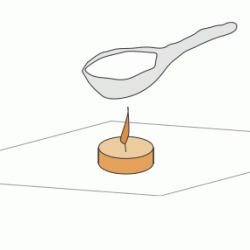Source Institutions
Source Institutions
Add to list Go to activity
Activity link broken? See if it's at the internet archive

In this activity about combustion and energy, learners observe a burning candle in a sealed jar and the burning of white sugar. The first part of the activity (candle burning) should be conducted as a demonstration. The second part may be conducted by learners working in groups of 2-4 or as a demonstration. This activity guide includes background information, questions for learners to think about, and bilingual (English/Spanish) handouts.
- 10 to 30 minutes
- 45 to 60 minutes
- $1 - $5 per group of students
- Ages 8 - 14
- Activity, Demonstration, Experiment/Lab Activity, Lesson/Lesson Plan
- English, Spanish
Quick Guide
Materials List (per group of students)
- Clear beaker, 1,000-mL (or tempered glass bowl)
- Matches
- Tea candles
- Wet paper towels
- 1/2 tsp of white sugar
- Small piece of aluminum foil (15 cm square)
- Copies of "Sugar as Fuel" student sheet
Subjects
-
Earth and Space Science
-
Earth Structure
- Atmosphere
- Biosphere
-
Earth Structure
-
Life Sciences
- Cells
-
Ecology
- Energy Flow and Chemical Cycles
-
Physical Sciences
- Heat and Thermodynamics
- Energy
-
Chemistry
- Chemical Reactions
- Oxidation-Reduction Reactions
-
Structure and Properties of Matter
- Elements and Periodic Table
-
The Nature of Science
-
The Scientific Process
- Conducting Investigations
- Gathering Data
- Formulating Explanations
- Communicating Results
-
The Scientific Process
Informal Categories
- Food and Cooking
Audience
To use this activity, learners need to:
- see
- see color
- read
- touch
Learning styles supported:
- Involves teamwork and communication skills
- Involves hands-on or lab activities
Other
Foreign language versions of this resource:
Components that are part of this resource:
This resource is part of:
Access Rights:
- Free access
By:
- Moreno, Nancy P. ; Tharp, Barbara Z. ; Dresden, Judith
Rights:
- All rights reserved, Baylor College of Medicine, 2011
Funding Sources:
- National Institute of Environmental Health Sciences (NIEHS) of the National Institutes of Health (NIH), R25 ES06932
- National Institute of Environmental Health Sciences (NIEHS) of the National Institutes of Health (NIH), R25 ES010698
